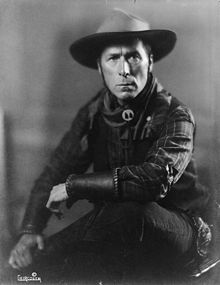William S. Hart
William Surrey Hart (born December 6, 1864 in Newburgh , Orange County , New York , † June 23, 1946 in Newhall , California ) was an American film actor , director , screenwriter and film producer of the silent film era . At times he was one of the most popular film stars in Hollywood and his western films became major milestones in the genre.
Career
Hart came to New York in 1888 , where he began studying acting with FF Markey. He traveled with touring theaters and appeared on Broadway , including in 1899 in the role of Messala in the play Ben Hur . In 1905 he was successful there with The Squaw Man and also played in other western pieces.
In 1907 he was engaged in the film Ben Hur for the role of Messala, which he had already played in the theater. His actual entry into the film business did not begin until 1914 with a contract with Thomas Harper Ince . His acting debut in a feature film was the role of Jim Stoke in Reginald Barker's The Bargain . In the same year, Hart's first directorial work The Passing of Two-Gun Hicks , in which he also played the lead role. William S. Hart became known through numerous westerns , in each of which he played the leading role. In 1917 he accepted a lucrative offer from Adolph Zukor and went to Famous Players . In some of his films he had great artistic influence. He played his last role in 1925 in Tumbleweeds , where King Baggot officially directed, but he was practically responsible director and producer.
Hart was also active as a writer and published several volumes of western stories ( Pinto Ben and other stories , The Golden West Boys , Hoofbeats , The Law on Horseback and others), as well as his 1929 memoir entitled My Life - East and West . He spent the last 20 years of his life on his spacious ranch in Newhall, California near Santa Clarita , where a school and a park are named after him today. For a re-release of Tumbleweeds he spoke a prologue to the film in 1939 , in which he brings the plot of the film closer, but also remembers his past days in the film business and then finally says goodbye to the audience.
William S. Hart died in 1946 at the age of 81. He is buried in Green-Wood Cemetery , Brooklyn . For his contribution to the film industry, William S. Hart was awarded a star on the Hollywood Walk of Fame at 6363 Hollywood Blvd. honored.
reception
Hart is considered one of the first western heroes in film history . His success was based on a very authentic and expressive game. He also succeeded in expanding the previously limited psychological and content spectrum of the genre with various components. Hart embodied mostly ambivalent, sometimes broken characters, whose search for identity and support, as well as conflicts with their own, but also with social moral concepts, repeatedly lead to isolation. In these films, services to the general public or to individual people loved by the protagonist often go hand in hand with pain and personal defeat. This tragic element was frequently taken up in later western history. The most popular example is probably the western classic twelve o'clock noon , the main role of which, played by Gary Cooper , was often received as the reincarnation of the Hart characters. In the 1960s it finally became a cornerstone of a genre flow .
Hart's direct successor in the audience's favor, Tom Mix , was, however, the opposite of Hart in many respects. The western characters he portrayed were free of self-doubt and exaggerated all-rounders. This corresponded to the wishes of the audience at the time, who longed for a cheerful spectacle during the optimistic mood of the 1920s. Based on this, Mix was also referred to as a "glamor cowboy".
In 1922 Buster Keaton made the short film comedy The Frozen North , which is to be understood as a parody of Hart's western. Keaton mimicked the facial expressions and gestures of the cowboy star exactly.
Filmography (selection)
- 1907: Ben Hur
- 1914: His Hour of Manhood
- 1914: Bad Buck of Santa Ynez
- 1916: Hell's Hinges
- 1916: The Return of Draw Egan
- 1917: The Silent Man
- 1917: The Narrow Trail
- 1919: The Money Corral
- 1920: The Toll Gate
- 1921: White Oak
- 1923: Wild Bill Hickok
- 1924: Singer Jim McKee
- 1925: Tumbleweeds
- 1928: Things are happening in Hollywood (Show People) ( cameo )
Hart also appeared in many of his films alongside acting as a producer, director and screenwriter.
literature
- William Surrey Hart, My Life East and West , New York: Houghton Mifflin Company, 1929. Autobiography.
- Ronald L. Davis: William S. Hart: Projecting the American West. University of Oklahoma Press, Norman 2003, ISBN 978-0-8061-6503-5 . New edition as paperback 2020.
Web links
- William S. Hart in the Internet Movie Database (English)
- William S. Hart in the database of Find a Grave (English)
- Pictures by William S. Hart In: Virtual History
Individual evidence
- ^ Georg Seeßlen : History and Mythology of Western Films ; Pp. 30-32
| personal data | |
|---|---|
| SURNAME | Hart, William S. |
| ALTERNATIVE NAMES | Hart, William Surrey |
| BRIEF DESCRIPTION | American film actor, director, screenwriter, and producer of the silent film era |
| DATE OF BIRTH | December 6, 1864 |
| PLACE OF BIRTH | Newburgh , New York |
| DATE OF DEATH | June 23, 1946 |
| Place of death | Newhall , California |

